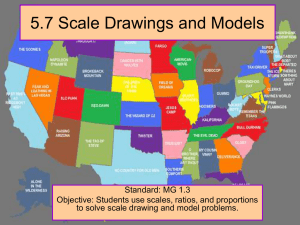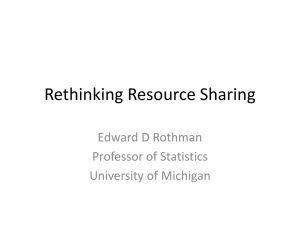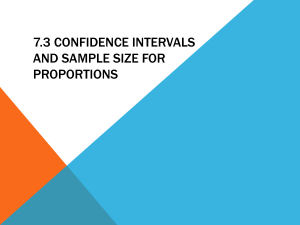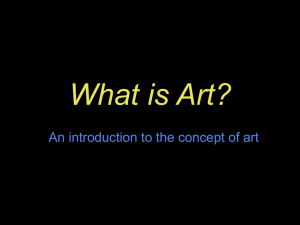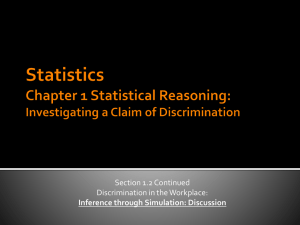Andy-Green
advertisement
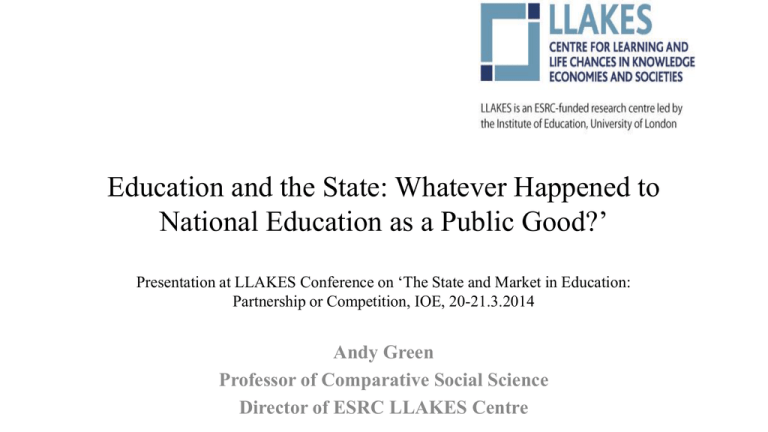
Education and the State: Whatever Happened to National Education as a Public Good?’ Presentation at LLAKES Conference on ‘The State and Market in Education: Partnership or Competition, IOE, 20-21.3.2014 Andy Green Professor of Comparative Social Science Director of ESRC LLAKES Centre Roadmap My objective here is to provide some historical and comparative perspective on the debate about the state and markets in education. • The role of the state in the creation of modern education systems in 19th C. in the West • and more recently in East Asia • Why the market has re-emerged as a major force in the era of globalization • The uneven global spread of educational marketization • The limits of educational markets • English education – advancing to the past The State and the Creation of Public Education Systems The creation of modern public education systems in the West in the 19th C. was essentially the work of the state. Markets (private groups with help from governments) had generated apprenticeships, some professional schools, and networks of religious schools, but nowhere had the resources or motive to supply universal public systems of education. This could only be done by states acting at local and national levels. States sometimes harnessed private initiative in building national education systems but were necessarily the main actors. Education and State Formation National education systems have generally developed as vehicles of state formation. They were designed to achieve collective objectives and to meet public needs (or the needs of the state as defined by the state). • Spreading dominant national languages • Promoting national/state identity • Inculcating the dominant ideologies • Forming citizens • Explaining the ways of the state to the people and the duties of the people to the state. Rapid State-Building – Rapid Education Development National education systems developed most rapidly in countries (like Prussia, France, the USA and later Japan) which were undergoing the most intensive and accelerated process of state formation. Usually • as a response to external military threats or territorial conflicts • to rebuild after revolutions and civil wars • to catch up economically with more advanced states Where there was little motivation towards state-building – as in 19th England and Italy before unification– educational development lagged considerably behind. Education and State Formation in East Asia As in the West in the 19th C. , the creation of public education systems in East Asia - in Japan in the 1870s and after and in the tiger economies after 1960 – was primarily the work of the state. It was part of an intensive process of state formation initiated in Japan during the Meiji Restoration and in the tigers after they gained independence (except in Hong Kong). In each case it was driven by a form of situational nationalism (Chalmers Johnson) born of a need to ensure the survival of states which were threatened from outside (Japan) or whose survival as newly independent states was threatened by a fragile geo-political situation (Castells). Nation-Building The very rapid development of public education systems in all these states was motivated by urgent public and collective objectives. • Consolidating new national identities • Integrating communities and fostering social cohesion • Spreading common languages in diverse communities (English and Mandarin in Singapore) • Forging a disciplined workforce and developing the skills for economic growth • Developing the capacity of the state bureaucracies. Public and Private Partnership East Asian education systems – excepting Singapore’s - made use of substantial private investments (in secondary school and university fees and tuition in tutorial schools) which allowed provision to grow more rapidly but the development of education was clearly driven and controlled by the state. • The initial investment in public education came mostly from government and fees only became a substantial part of total funding as families became affluent enough to contribute. • Private secondary schools and universities tightly regulated and partfunded by the state. • Strong educational bureaucracies at national and regional levels. Centralised School Systems Until quite recently, the East Asian education systems were highly centralized: • Quite standardized structure of schools - in Japan, South Korea and Taiwan following the US 6-3-3 pattern and with neighbourhood, non-selective, comprehensive schools with mixed ability classes and strong emphasis on interactive classroom teaching. • Little school autonomy • Equal resource distribution between schools (with rotation of head and teachers in some cases). • National systems of examination controlled by the state • Strongly prescriptive national curricula with state authorization of textbooks (Japan) and state-provided instruction materials (Singapore). Centralisation allowed had the benefit of: • Allowing states to plan education development and skills flows (including through quota in different subjects) and integration skills supply with economic demand. • Embedding normative values and standards which helped by drive up educational achievements State-Led Development and Manpower Planning Economic growth in Japan and the tigers was exceptionally state-led. Developmental states used their powerful and highly competent bureaucracies to plan economic development (Chalmers Johnson, Kohli) and to coordinate skills supply and demand in dynamic ways (Ashton, Green et al; Green, 2013). • Industrial Policies for growth in particular sectors tied to • Manpower planning • Increasing the supply of skills in particular areas in anticipation of future demand • Using state levers to drive up employer demand for skills (wage minima, taxes on low paying firms, deals of skills transfer with MNCs – see Schein). Public Purposes Drive Educational Development East Asian education systems have become less centralized over time. But during the early years of rapid economic growth, state-led development of fairly standardized education systems proved extraordinarily effective, and these states now have amongst the highest enrolments and highest standards in core skills of any in the world. Asian families have traditionally had a high regard for education and are willing to invest heavily in it. This cultural legacy plus the rising opportunities provided by rapid economic growth no doubt motivated students to work hard and drove up achievement. But what drove the rapid development of education most were shared public objectives for economic growth and nation-building. Drivers of Education Marketisation Public education systems remain the norm across the world, and state-funded schools still greatly outnumber private schools, but there is no doubt that there has been a major shift towards marketising education in many countries during the past 30 years. This is driven by a number of factors – some politically contingent, some more secular trends. • Increasing economic globalization and technological advance since the 1980s has intensified economic competition and the shift towards the ‘knowledge economy’, thus exponentially increasing the demand for skills. • Governments find it hard pay the rising costs of meeting this demand and look to share costs with users. • Corporations searching for new profit opportunities increasingly lobby to provide public services, national and globally (Ball et al). • Where opportunity and mobility is curtailed (Brown’s ‘the opportunity trap’) more aspirational families increasingly seek positional advantage for their children and lobby for more school diversity and choice. • With a dominant neo-liberal paradigm of globalization, international bodies which drive what Pasi Sahlberg calls the ‘Global Education Reform Movement’ have relentlessly advocated new public management policies which ape private sector practices. Challenging Some Myths of Global Education Policy (and research) While the trends towards educational marketization in some countries is real it is important to avoid falling for the claims that it is all inevitable and convergent. In fact the policy rhetoric of the GERM is much more uniform that what actually happens on the ground (Steiner-Khamsi; Green and Mostafa). • Marketisation is a very uneven process • Despite the rhetoric of GERM, there is very little evidence that educational markets – with enhanced competition, school diversity and choice etc – improve standards. • There is nothing inevitable about educational marketization – it depends on national political decisions – at least in the countries rich enough not to be dependent on aid agencies – globalization is not inevitable or a one-way street. Private Shares in Spending on Education – Slight Increase but Not Converging Significantly Small increase in % of total education spending deriving from private sources (sub set country average increased from 13.7 % in 2000 to 16.5 % in 2008), with a non-significant convergence across countries during the period (CV from 0.83 to 0.66; P=0.801). • Liberal countries tend to have the highest proportion of spending coming from private sources (23.8 % in 2008). • The proportion was lower in the Social Market (11.2 %) and Southern European countries (10.3 %) and lowest in the Social Democratic countries (5.5 % in 2008). • The country group averages have not converged much during the period (CV from 0.7 to 0.6) - continuing polarisation of the Liberal and Social Democratic state. Trends in Private Shares in Total Educational Spending, 2000, 2008. Private Spending on Tertiary Education – Up but No Significant Convergence • Share of private funding in spending on tertiary education is higher and rose during the period (from an average of 26.7 % in 2000 to 32.1 % in 2008) • No significant convergence across countries (CV from 0.883 to 0.774; P=0.67). • Liberal countries tend to have the highest share, followed by the Social Market countries, and with the Social Democratic countries having the lowest, by a long way. • No significant convergence in the country groups during this period (CV from 0.974 to 0.902). Proportion of Total Tertiary Education Funding from Private Sources , 2000 and 2008. Distribution of Public and Private Schools – Slight Convergence but not towards Privatisation PISA data show little evidence of widespread privatisation of schools between 2000 and 2009. • Proportion of schools classified as ‘Private Independent’ rose slightly across countries, from 4.25 percent to 4.42 % (with significant convergent trend (p=0.026)). • Proportion classified as ‘Private Dependent’ declined from 14.92 % to 14.01 % . • Proportion of schools which are defined as ‘Public’ (ie neither ‘Private Independent’ nor ‘Private Dependent’) increased slightly between 2000 and 2009 (from 80.81 % to 81.57 % ) in a slightly convergent trend (CV from 0.29 in 2000 to 0.25 in 2009; P=0.033). The slight increase in the relative shares of private spending on education may be due to increases in levels of fees or other educational costs to parents, illustrating a trend towards ‘marketisation’ of public organisations, but do not signal widespread privatization of schools per se. Proportion of all Schools Which are Public Selection by Ability – Declined, No Convergence Reports by head teachers on their schools for PISA suggests that selection to schools by ability (i.e. academic records) has decreased across OECD countries. • Proportion reporting records ‘always’ being used in selection declined from 26.24 % in 2000 to 24.26 % in 2009. • Proportion reporting their schools ‘never’ used academic records to select rose from 52.67 % in 2007 to 55.44 % in 2009. The country groups are sharply distinguished on questions of selection. Proportion Saying ‘Never Select by Ability’ Ability Grouping – Declining in Slightly Convergent Trend Reports by heads suggest ability grouping has become less common across the OECD. • The proportion of schools in each country reporting ability grouping in all subjects went up in two countries and down in 20 countries. The average proportion across countries declined from 39.01 % to 12.7 % in a convergent trend (CV from 1.82 to 0.97; P= 0). • The average for the proportion of schools in each country not practicing ability grouping in any subject rose from 25.24 % in 2003 to 32.04 % in 2009. • However, this is counteracted by the higher proportion of schools adopting ability grouping ‘in some subjects’ which has gone up in 15 countries and down in seven countries. Proportion of Schools Reporting Ability Grouping in ‘No Subjects’ by Country, 2003, 2009. Decisions Made at School Level - Non-Convergent Decline OECD data collected from panels of country experts suggest that the number of decisions made at the central level has risen on average across countries whereas the number of decisions made at the school level has decreased. • Between 2003 and 2011 local decision-making decreased in ten out of 21 countries and increased in only four. • No significant convergence across countries on this measure (CV 0.477 in 2003 and 0.499 in 2012; p=0.285) and across country groups there were signs of divergence (CV from 0.195 to 0.273). This flies in the face claims of a common and convergent trend towards decentralisation (Astiz et al, 2002). Proportion of Decisions Made at School Level across Country Groups in 2003 and 2011 Neo-Liberal Countries don’t do Better Numeracy Means by Country and Age Group – From SAS Literacy Means by Country and Age Group Finland – The European Champion Finland consistently outperforms other western countries in International Surveys of Achievement in Literacy, Numeracy and Science (PISA and SAS). Is it a paragon on Global Education Policy with its preference for school choice, diversity and competition and tough accountability regimes for schools and teachers? Hardly. • • • • • School quality not driven by competition between schools A relatively standardized system with little school choice and diversity Comprehensive schools with no ability grouping No national testing regime No school inspection system But: • High levels of teacher training, professionalism and autonomy. Effects of Marketisation in England Dismantling the National Education System Increasing marketization in England is rapidly dismantling the public education system and creating in its stead a patchwork of provision of the sort that we had before 1870. An obsession with school choice and diversity, and competition between schools, is leading to creation of multiple types of school with different governance and funding, admissions procedures and curriculum priorities. The current list includes free schools, faith schools, studio schools, university technical colleges and academies of various kinds, including sponsored academies, chain academies (ARK, ULT, AET etc) and converter academies. Providers include charities, foundations, social enterprises, faith and community groups and private education businesses. Local Education Authorities have been eviscerated and local planning eroded. The Effects of Marketisation in England This patchwork of providers and school types, not to mention the byzantine complexity of the awarding bodies and certificates, lacks transparency to such a degree that only the most ‘savvy’ and well-informed of parents and students can navigate it. This: • provides unfair advantages to better off, more mobile, and better informed parents • creates more social segregation in schools with less balanced intakes. As the Sutton Trust recently found the proportion FSM pupils with 5 good GCSEs in the top 500 comprehensive is below half the national average. 95% of these schools take fewer FSM students than the proportion in their local area. The OECD (2010) found that school intakes explain 77% percent of the variation in school performance in England – only topped by Luxemburg and way higher than the OECD average of 55%. The fragmented nature of provision undermines any sense of normative standards and expectations for young people and will create greater inequality of outcomes in a country which already has one of the most unequal educations systems in the OECD. The Low-Trust System Consumer ‘choice’ in the market – or rather choice for some consumers – is replacing any kind of local democratic control of schooling. • Local authorities lack power, teacher unions and professional associations are sidelined, and parental influence on school governing bodies is weakened in schools which are run as businesses. • At the same time, central government has assumed more and more powers – with the office of Secretary of State for Education acquiring 2500 new powers since 1960, which in recent years have been exercised more and more arbitrarily. • Teacher motivation and professionalism are undermined by constant policy shifts and criticism from government, as well as draconian ‘accountability systems’ – so that schools have become low-trust institutions – the opposite of what characterizes the successful Finnish system. Neither Excellence nor Equality Despite all the stress on standards, and the obsession with ‘performativity,’ marketization does not appear to be delivering its declared objective of raising standards in England, or at least not in the things that we can measure accurately. More exams are passed but in the tests of literacy and numeracy in the recent SAS 16-25 year olds in England scored worse than in all but two other countries and, uniquely amongst countries, no better than the 55-65 year olds. They also performed worse than the same age group in IALS conducted 16 years previously, although the difference is not significant (NFER). This is not surprising in a way given the highly unequal outcomes of our education system. The best achieve reasonably well on international tests, relative to those in other countries, but we have a longer tail of low achievers than most countries which brings down the mean scores. As OECD PISA reports repeatedly show, equality and excellence are far from incompatible and many of the best performing systems are also the most egalitarian (Finland and Japan for instance). In England excessive inequality in income and skills is not only associated a range of unwanted social outcomes – from low trust and public health, to high obesity, teenage pregnancy and violent crime . Educational inequality is also undermining overall standards in education and threatening our future skills base. A Nineteenth Century Education System? The excessive marketization of education in England, which reduces schooling to competitive individual consumption, is undermining the important public purposes of education, including producing the skills for England to compete economically in the world and, equally important promoting opportunity and social cohesion. Neo-liberal policies are taking us back rapidly to the Victorian era when Britain was widely regarded as one of the worst educated countries in northern Europe. A Select Committee in 1818 reported that ‘England is the worst educated country in Europe’ and by 1902 Prime Minister Balfour could still say that ‘England is behind all continental rivals in education.’ After the last 30 years of market liberalism, are we in danger of the same being true today?” Re-Building a Democratic and Integrated System Rather than obsessively fostering diversity and choice, and individual competition, we need to re-capture the high collective and public aspirations which inspired the remarkable creation of public education systems. England needs to re-build an integrated public system, with local democratic planning and control, where all children have access to decent local schools with high aspirations. • Restore local elected education authorities • - Create a more consistent provision of quality with A single system of high quality, non-selective comprehensive schools more balanced intakes (through admission systems based on lotteries or banding in redrawn catchment areas) Human resources distributed more equally across schools (including through rotating heads and teachers) Enhanced resourcing for schools in more deprived areas (including the provision of additional out of school and vacation support) • Support teacher professionalism and respect in more high trust institutions. Education and State Formation: Europe East Asia and the USA Andy Green Palgrave, 2013

